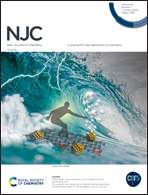Nano-flower S-scheme heterojunction NiAl-LDH/MoS2 for enhancing photocatalytic hydrogen production†
Abstract
The construction of heterojunctions can effectively improve the electron transport rate and photocatalytic activity. In this work, nanoflower-like S-scheme heterojunction MoS2/NiAl-LDH was successfully synthesized. The results indicated that the hydrogen yield of the MoS2/NiAl-LDH composite catalyst reached 229.5 μmol in 5 hours under visible light irradiation by adjusting the pH value of the sacrificial agent and the amount of eosin. The crystal structure and morphological characteristics of the composite were analyzed by XRD, SEM and TEM. The visible light response degree and charge separation and transfer rates of photogenerated carriers of the composite were analyzed by UV-Vis DRS, PL and electrochemistry. The electronic transfer path was also analyzed by XPS. The construction of S-scheme heterojunctions can realize effective separation of electron–hole pairs and ensure that the photo-induced carriers with the strongest redox ability can be retained to participate in the photocatalytic reaction. In addition, the feasible mechanism of photocatalytic hydrogen evolution is given. This work will provide different insights into the enhancement of hydrogen evolution by heterojunctions formed by binary semiconductors.



 Please wait while we load your content...
Please wait while we load your content...